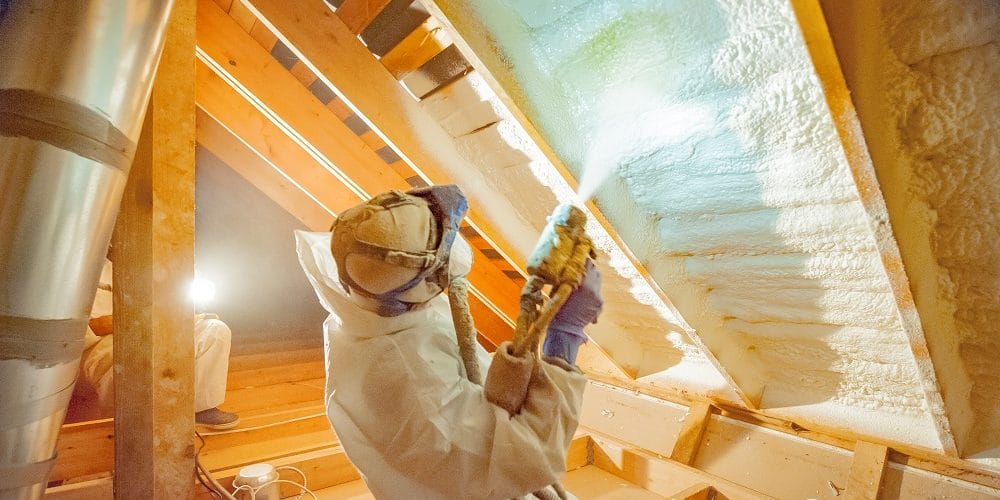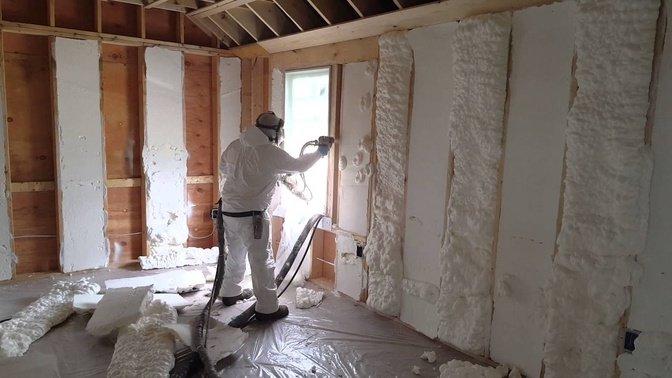How Spray Foam Insulation Helps Achieve Energy Goals in Riviera Beach, MD
For residents who set goals to make their homes more efficient but aren't sure where to start, understanding how spray foam works as a comprehensive solution can clarify the path to a less wasteful and more comfortable home.

For homeowners in Riviera Beach, spray foam insulation is one of the most effective tools for achieving energy goals because it uniquely addresses the two primary sources of energy loss: heat transfer and air leakage. Unlike traditional insulation, which mainly slows down heat transfer, spray foam expands to create a complete air seal. This stops drafts and prevents conditioned air from escaping, dramatically reducing the workload on heating and cooling systems. In a coastal Maryland climate with both humid summers and cold winters, this dual action of insulating and air sealing leads to significant reductions in energy consumption, lower utility bills, and a smaller carbon footprint. For residents who set goals to make their homes more efficient but aren't sure where to start, understanding how spray foam works as a comprehensive solution can clarify the path to a less wasteful and more comfortable home.
Tackling Energy Waste at its Source
Every home loses energy in two main ways. The first is conduction, which is heat moving through solid materials like wood studs and drywall. The second is convection, which is heat carried by moving air, better known as drafts. To meet any serious energy reduction goal, a homeowner must address both.
Traditional insulation, like fiberglass batts, is designed to slow down conduction. The material traps air in small pockets, resisting heat transfer. However, it does very little to stop air movement. Batts are cut to fit between studs, but they often leave small gaps and are difficult to fit perfectly around pipes and electrical boxes. Air can flow freely through these gaps, carrying expensive heated or cooled air with it.
Spray foam insulation, on the other hand, is applied as a liquid that expands to fill every single crack and crevice before it cures. This creates a solid, continuous barrier that does two jobs at once:
- It has a high R-value, meaning it effectively resists conductive heat transfer.
- It forms a complete air seal, which stops convective heat loss.
This comprehensive approach is what makes it so effective, creating the difference between wearing a knit sweater on a windy day versus wearing a windproof, insulated jacket. Both provide warmth, but only one stops the wind from cutting through.
The Power of a Complete Air Seal
The impact of air leakage on a home's energy use is often underestimated. According to some energy sector studies, uncontrolled air leakage can account for up to 40% of the energy used for heating and cooling. This is like leaving a window open all year long. Air leaks are common around the edges of the foundation, where walls meet the attic, and through small penetrations for wiring and plumbing.
By expanding to create a solid seal, spray foam effectively eliminates these leaks. The result is a home that is much easier and cheaper to keep at a comfortable temperature. The HVAC system no longer has to fight against a constant flow of outside air, allowing it to run less often and for shorter cycles. This not only saves a huge amount of energy but also reduces wear and tear on expensive equipment. As a simple test, homeowners can often feel for drafts around electrical outlets and light switches on exterior walls on a breezy day. These are common air leakage points that spray foam can easily seal from within the wall cavity.
Specific Challenges for Homes in Riviera Beach
The climate in Riviera Beach and the surrounding coastal Maryland area presents a distinct challenge that spray foam is uniquely equipped to handle. The hot, humid summers and cold, damp winters demand an insulation solution that can manage both temperature and moisture.
Summer Humidity Control
In the summer, air conditioners have to do two jobs: cool the air and remove moisture from it. The high humidity in Riviera Beach makes this second job especially difficult and energy-intensive. Traditional insulation does nothing to stop moisture-laden air from infiltrating the home. Closed-cell spray foam, however, is a certified vapor barrier. It blocks the movement of water vapor, keeping the humid outdoor air from getting inside. This reduces the dehumidification load on the AC system, allowing it to cool the home more efficiently and use less electricity.
Winter Draft and Moisture Prevention
In the winter, the goal is to keep warm, moist indoor air from escaping and cold, damp air from entering. The air seal created by spray foam stops cold drafts completely. It also prevents the warm indoor air from contacting the cold exterior sheathing inside the walls, which is where condensation can form. By stopping this process, spray foam helps prevent the moisture that can lead to mold, mildew, and wood rot.
Energy Performance Comparison

Here’s a direct comparison of how spray foam stacks up against traditional insulation on key performance metrics:
| Feature | Spray Foam Insulation | Traditional Insulation (Fiberglass) |
|---|---|---|
| Air Leakage Control | Excellent; creates a continuous air barrier. | Poor; leaves many gaps for air to pass through. |
| Moisture Management | Excellent; closed-cell foam is a vapor barrier. | Poor; can absorb moisture, leading to mold. |
| R-Value Stability | Very high; maintains R-value over its lifetime. | Can degrade over time as it settles or gets wet. |
| Lifespan | Lasts for the life of the building. | May need to be replaced or supplemented after 15-20 years. |
Things to Consider Before Making a Decision
To ensure spray foam helps a homeowner achieve their energy goals, a few factors should be considered first.
A Professional Energy Audit
Before investing in new insulation, a professional energy audit is a smart first step. An auditor can use tools like a blower door test to measure a home's exact air leakage rate and an infrared camera to see where heat is escaping. This provides a clear, data-driven plan for where insulation will have the biggest impact, ensuring the investment is targeted for maximum results.
Your Specific Energy Goals
Are you aiming for a specific percentage reduction in your utility bills? Are you planning to install solar panels and want to reduce your home's load first? Having clear goals helps the insulation contractor design the right solution, whether it's just insulating the attic or doing a full building envelope upgrade.
The Installer's Expertise
The performance of spray foam is directly tied to the quality of the installation. A professional spray foam contractor in Riviera Beach knows how to prepare the surfaces, maintain the right chemical temperatures and pressures, and apply the foam to the correct thickness. An improper installation will not create a proper air seal and will fail to deliver the expected energy savings. It's also a good idea to ask potential contractors about their certifications and training. A reputable company will be transparent about their crew's qualifications and the specific products they use.

Questions People Ask About Achieving Energy Goals
How much money can spray foam really save me?
While it varies depending on the home's condition before the upgrade, it is common for homeowners to see savings of 20% to 40% on their heating and cooling costs. For some very leaky, poorly insulated homes, the savings can be even higher.
Can I get any rebates for installing spray foam?
Energy efficiency upgrades like spray foam insulation often qualify for federal tax credits. Additionally, local utility providers sometimes offer rebates for improvements that reduce energy demand. Homeowners should check with their utility company and a tax professional for current programs.
Is spray foam a good investment before getting solar panels?
Yes, it's one of the best investments to make before going solar. By drastically reducing a home's energy consumption first, you can often install a much smaller, less expensive solar panel system to meet the remaining energy needs.
Where is the best place to install spray foam for the biggest energy savings?
For most homes, the attic is the highest priority. A tremendous amount of energy is lost through the roof due to heat rising in the winter and the sun beating down in the summer. Insulating and air sealing the attic provides the most significant and immediate return on investment.
Will a spray foam insulated home feel different?
Yes, it will feel much more comfortable and consistent. The drafts will be gone, and the temperature will be much more even from room to room and floor to floor. The home will also be noticeably quieter.
Working With an Insulation Expert
For homeowners in Riviera Beach with clear energy goals, spray foam insulation offers a direct and effective path to achieving them. By creating a superior thermal and air barrier, it addresses the root causes of energy waste, leading to lower bills, greater comfort, and a more sustainable home. The key is to work with a professional who can assess the home's unique needs, perform a high-quality installation, and explain the most effective options for your specific goals. For residents in the area, a company like Peninsula Insulation has deep experience with the local climate and housing stock. They can be reached for a consultation by calling (410) 770-2624 or by sending an email to wil@mdsprayfoam.net.
Author: Wil Perkins is the founder of Peninsula Insulation and a long-time resident of Easton, Maryland. With a hands-on approach and nearly five years in the insulation business, Wil leads a team known for professional service and quality work. He’s committed to providing best Spray Foam Insulation solutions and lasting results for every project.
Reviewer: Emily Martinez has 12 years of experience in spray foam insulation. She reviewed this article and suggested ways to make the content more useful for contractors looking to grow their customer base.